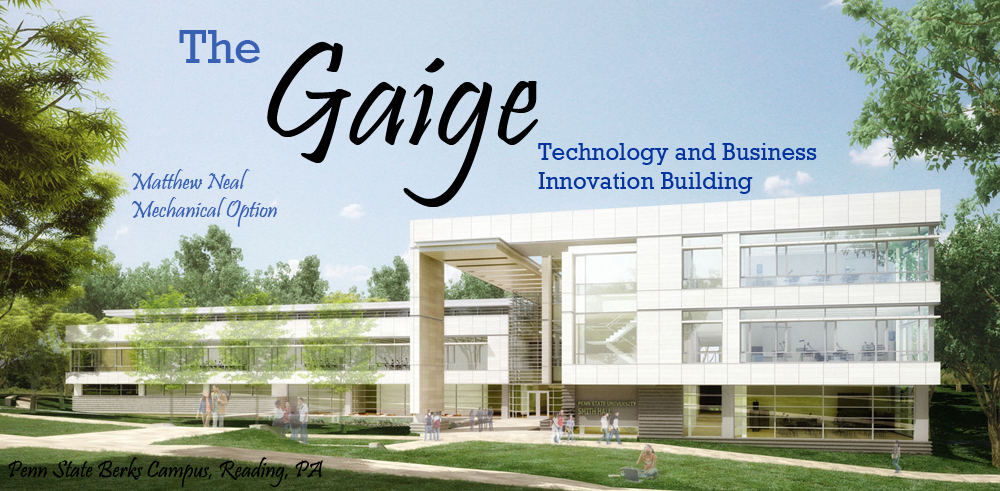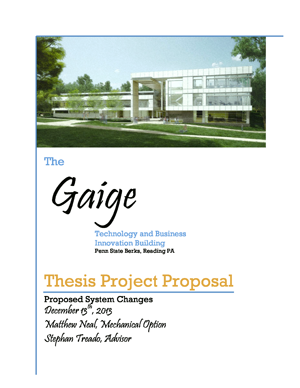

sssssss
Below is a link tothe Thesis proposal that has been submitted, outlining the work that will be done during the Spring semester of 2014 for futher analysis of potential design alternatives for the Gaige Building.
Below is a link to the revised proposal that has been approved for the spring semester:
Mechanical Depth 1: Geothermal Analysis
The main analysis of the Gaige Building will be the option of creating a centralized service for the entire Berks campus, supplied by a field of geothermal wells. The wells would be vertical bores located in some of the existing open space that is already central to campus operations. Not only will drastic benefits be seen by installing a geothermal system on campus buildings, but a strong amount of load diversity will be gained as well. First, an analysis of the cost and benefits of utilizing the geothermal potential in Reading, PA will be analyzed, and then, the overall gains will be determined from creating a campus-wide system, gaining load diversity all across the many different campus building types. Below, figure one shows the current campus map, and the many different building that are present on campus. As you can see, the red circles highlight key areas of campus that have large, open spaces. These areas are good spaces where geothermal wells could be bored to create a central service to the entire campus. And if the wooded area is meant to be conserved, bores could be done under current parking areas or some of the athletic fields as well. The area is not extremely urban or dense, so such a field could be a feasible option.
Trace 700 will be used to analyze first the impact of a geothermal system specifically on the Gaige Building, and then a simplified trace model will help to show the overall benefits of the potential impact on the campus as a whole. The trace model of the whole campus will simplify each building to a space type with certain loading criterion and diversity profiles, simply to see the benefits that might be reached. The changes to a geothermal system will be analyzed and reported success will be shown using life-cycle cost analysis to show feasibility. This will serve as the first, and most significant, depth for the thesis work coming up in the fall.
Mechanical Depth 2: Ductwork Redesign
If a geothermal system is installed in the Gaige Building, the ventilation air system will then need to be separated from the rest of the building's heating and cooling system. To do this, a dedicated outdoor air system (DOAS) will be used to provide variable levels of outside air to the building spaces. Also, a new heating and cooling system will need to be used in the Gaige Building. For this system, various alternatives will be considered, but the main, and most compatible system with geothermal design are heat pumps. With the addition of a heat pump system on a space-to-space basis, the entire ductwork system, for both the heating and cooling system and the heat pump system, will need to be redesigned and coordinated.
The second depth of the thesis will consist of the ductwork redesign and the implementation of separate ventilation and heating/cooling systems. With a DOAS system, also the benefits from reduced outside air consumption will be determined and included in the analysis. The new systems will be coordinated in the redesign of the ductwork system. Now, two separate but smaller in size duct systems will be running throughout the building, creating some necessary coordination issues that will need to be resolved. A Revit model will be created to help assist with the redesign of the ductwork in the Gaige Building.
Cost and Scheduling Breadth
When switching the proposed mechancial system to a geothermal well field supplied system, there will be much adjustments to the overall cost and schedule of the project. Initially, with the proposed depth of using geothermal wells for the Gaige Building, there will be an increased initial cost. This analysis will first look at the adjustments that will be made to the projects overall schedule now that boreholes will be drilled during construction. Also, along with work done in the depth, the increased intial project cost will be considered, along with the energy savings that will be seen over time with the new system.
Acoustics Breadth
For the acoustics breadth, the impact of the new air distribution system will be analyzed. Now that the Gaige Building will be supplied with geothermal wells, the space conditioning will be done through a heat pump system, and the outside air will be done using a dedicated outdoor air system (DOAS). To make these chages, the entire supply air system will be redesigned to accomodate the DOAS. This ductwork will be calculated to ensure that an adequate NC level is met for background noise in each particular space, dependign upon occupancy classification. Also, since individual heat pumps will now be located in adjacent rooms or potentially in the ceiling plenum of noise sensative spaces, such as the classrooms or the offices, analysis will be done to ensure that proper partitions are specified. Also, the heat pump placement will be analyzed to ensure that background noise levels of the acoustically sensative spaces are met.
Honors Work
Since this thesis will also count as my honors thesis for the Schreyer Honors College, an aditional aspect of the project will be performed to account for this. With my strong interest in acoustics, I will plan a trip on site to measure various room acoustics parameters in the Gaige Building as it currently is designed. I plan to take reverberation time and transmission loss measurements at various classroom and office spaces within the Gaige Building. This data will help to report on the current quality of the room acoustics at the Gaige Building. Then, potential changes to the design will be proposed, in order to ensure that the Gagie Building has adequate room acoustics and sound isolation.
If possible, I am also working to give some third year students in AE 309 the opportunity to come and help with the measurements. This will provide them with a valuable out of the classroom opportunity to conduct real world acoustic tests of a building. This trip would give students honors optioning AE 309 a project that would count towards thier honors coursework as well. Although this aspect of the project is less tied into my depth mechanical analyses, the main goal of this aspect is to create an educational experience for myself, along with an education opportunity for other third year AE students.

